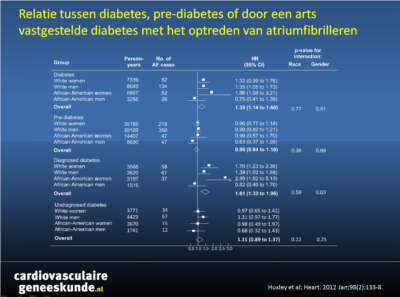ARIC: Relatie tussen type 2 diabetes en atriumfibrilleren
Literatuur - Huxley RR et al; Heart. 2012 Jan;98(2):133-8ARIC: Relatie tussen type 2 diabetes en atriumfibrilleren
Huxley RR, Alonso A, Lopez FL, Filion KB, Agarwal SK, Loehr LR, Soliman EZ, Pankow JS, Selvin E.
Heart. 2012 Jan;98(2):133-8.
Achtergrond
In sommige studies is type 2 diabetes in verband gebracht met een verhoogd risico van AF [1-3]. De relaties tussen de markers van de glucose homeostase en AF zijn niet uitgebreid bestudeerd. In de Atherosclerosis Risk in Communities studie (ARIC) werd dit verband onderzocht in een populatie van blanke individuen en Afro-Amerikanen.Belangrijkste resultaten
Personen met diabetes hadden een groter risico op het optreden van AF in vergelijking met mensen zonder (HR 1.35, 95% CI 1.14-1.60, fig 1.). Personen met pre-diabetes of niet-gediagnosticeerde diabetes hadden geen verhoogd risico in vergelijking met mensen zonder diabetes.Conclusie
Patiënten met gediagnostiseerde diabetes hebben een hoger risico van AF. De onderliggende mechanismen zijn nog onduidelijk, de invloed van diabetes op het risico van AF lijkt alleen te ontwikkelen na een langdurige blootstelling aan diabetes.Referenties
1. Finn Go AS, Hylek EM, Phillips KA, et al. Prevalence of diagnosed atrial fibrillation in adults: national implications for rhythm management and stroke prevention: the AnTicoagulation and Risk Factors in Atrial Fibrillation (ATRIA) Study. JAMA 2001;285:2370e5.2. Huxley R, Barzi F, Woodward M. Excess risk of fatal coronary heart disease associated with diabetes in men and women: meta-analysis of 37 prospective cohort studies. BMJ 2006;332:73e8.
3. Frost L, Hune LJ, Vestergaard P. Overweight and obesity as risk factors for atrial fibrillation or flutter: the Danish diet, cancer, and health study. Am J Med 2005;118:489e95.
Abstract
BACKGROUND: Type 2 diabetes has been inconsistently associated with the risk of atrial fibrillation (AF) in previous studies that have frequently been beset by methodological challenges.
DESIGN: Prospective cohort study.
SETTING: The Atherosclerosis Risk in Communities (ARIC) study.
PARTICIPANTS: Detailed medical histories were obtained from 13 025 participants. Individuals were categorised as having no diabetes, pre-diabetes or diabetes based on the 2010 American Diabetes Association criteria at study baseline (1990-2).
MAIN OUTCOME MEASURES: Diagnoses of incident AF were obtained to the end of 2007. Associations between type 2 diabetes and markers of glucose homeostasis and the incidence of AF were estimated using Cox proportional hazards models after adjusting for possible confounders.
RESULTS: Type 2 diabetes was associated with a significant increase in the risk of AF (HR 1.35, 95% CI 1.14 to 1.60) after adjustment for confounders. There was no indication that individuals with pre-diabetes or those with undiagnosed diabetes were at increased risk of AF compared with those without diabetes. A positive linear association was observed between HbA1c and the risk of AF in those with and without diabetes (HR 1.13, 95% CI 1.07 to 1.20) and HR 1.05, 95% CI 0.96 to 1.15 per 1% point increase, respectively). There was no association between fasting glucose or insulin in those without diabetes, but a significant association with fasting glucose was found in those with the condition. The results were similar in white subjects and African-Americans. CONCLUSIONS: Diabetes, HbA1c level and poor glycaemic control are independently associated with an increased risk of AF, but the underlying mechanisms governing the relationship are unknown and warrant further investigation.


Deel deze pagina met collega's en vrienden: